Build Your Own Programming Language, Second Edition

eBook Details:
- Paperback: 556 pages
- Publisher: WOW! eBook; 2nd edition (January 30, 2024)
- Language: English
- ISBN-10: 1804618020
- ISBN-13: 978-1804618028
eBook Description:
Build Your Own Programming Language, 2nd Edition: A programmer’s guide to designing compilers, DSLs and interpreters for solving modern computing problems. Written by the creator of the Unicon programming language, this book will show you how to implement programming languages to reduce the time and cost of creating applications for new or specialized areas of computing.
The need for different types of computer languages is growing, as is the need for domain-specific languages. Building your own programming language has its advantages, as it can be your antidote to the ever-increasing complexity of software.
In this Build Your Own Programming Language, Second Edition book, you’ll start with implementing the frontend of a compiler for your language, including a lexical analyzer and parser, including the handling of parse errors. The book then covers a series of traversals of syntax trees, culminating with code generation for a bytecode virtual machine or native code. You’ll also manage data structures and output code when writing a preprocessor or a transpiler.
Moving ahead, you’ll learn how domain-specific language features are often best represented by operators and functions that are built into the language, rather than library functions. We’ll conclude with how to implement garbage collection. Throughout the book, Dr. Jeffery weaves in his experience from building the Unicon programming language to give better context to the concepts. Relevant examples are provided in Unicorn and Java so that you can follow the code of your choice. In this edition, code examples have been extended and further tested.
- Perform requirements analysis for the new language and design language syntax and semantics
- Write lexical and context-free grammar rules for common expressions and control structures
- Develop a scanner that reads source code and generate a parser that checks syntax
- Build key data structures in a compiler and use your compiler to build a syntax-coloring code editor
- Write tree traversals that insert information into the syntax tree
- Implement a bytecode interpreter and run bytecode generated by your compiler
- Write native code and run it after assembling and linking using system tools
- Preprocess and transpile code from your language into another high level language
- Implement garbage collection in your language
By the end of this Build Your Own Programming Language, 2nd Edition book, you’ll be able to build and deploy your own domain-specific languages, capable of compiling and running programs.
